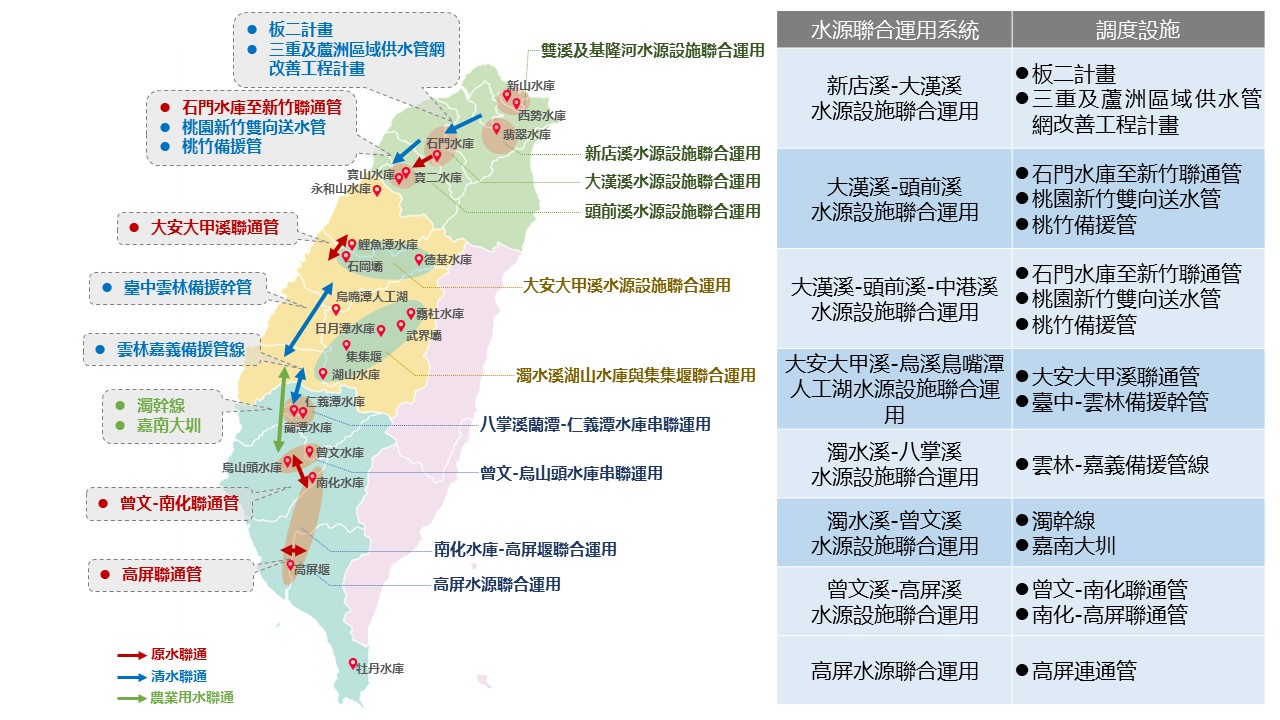Taiwan’s steep terrain and fast-flowing rivers make it difficult to retain water resources. In addition, rainfall distribution varies significantly across time and space. To enhance water resource utilization efficiency and mitigate the problem of uneven rainfall among regions, strengthening regional water source allocation has become a critical task to ensure stable water supply.
In the past, inter-regional pipelines have already been constructed, including: in northern Taiwan, Taipei supporting Keelung and Banxin, diversion of Dahan River water southward to Taoyuan, and Taoyuan supporting Hsinchu via trunk lines; in central Taiwan, Taichung supporting Changhua, Yunlin supporting Changhua and Chiayi; and in southern Taiwan, Tainan supporting Chiayi, as well as Tainan and Kaohsiung implementing joint water utilization through regional allocation pipelines.
In recent years, as climate change has intensified, the risk of drought has increased. For instance, during the severe drought from 2020 to the first half of 2021, no typhoons passed through Taiwan during the wet season, and average rainfall from June to September in major reservoir catchments reached only 20%–60% of the historical average. By the end of May 2021, the storage levels of three major reservoirs—Yongheshan, Liyutan, and Techi, which are crucial for supplying water to Hsinchu, Miaoli, and Taichung—had all dropped below 5%, resulting in extremely severe water conditions. Fortunately, the completion of the Taoyuan-to-Hsinchu trunk pipeline in February 2021 proved effective during the drought, ensuring water supply stability in the Taoyuan–Hsinchu region.
To further enhance water resource utilization efficiency and address uneven rainfall distribution across regions, strengthening regional water allocation remains an essential measure for stable supply. Therefore, in coordination with the Water Resources Agency (WRA), this Branch is implementing the Western Taiwan Water Supply Corridor Pearl String Scheme, aimed at creating a nationwide stable water supply pipeline network. This includes north-to-south water diversion, bidirectional transfers in central Taiwan, and south-to-north water diversion. The related projects are as follows:
Northern Region Projects: Xizhi–Keelung interconnection pipeline (under review), Sanchong and Luzhou regional water supply network improvement (under construction), Second Phase of the Banxin Area Water Supply Improvement Plan (completed), Shimen Reservoir–Hsinchu raw water interconnection pipeline (under construction), and Taoyuan–Hsinchu trunk pipeline (completed).
Central Region Projects: Liyutan Water Treatment Plant northbound pipeline to Miaoli (under construction), Da’an–Dajia River interconnection pipeline (under construction), Taichung–Yunlin regional water allocation pipeline improvement (under construction), and Zhuoshui Main Line–Northern Main Line interconnection (under construction).
Southern Region Projects: Zhuoshui Main Line–Northern Main Line interconnection (under construction), Zengwen–Nanhua interconnection pipeline (completed), Tainan–Kaohsiung interconnection pipeline (completed), and Nanhua–Gaoping interconnection pipeline (completed).
Cross-Basin Joint Operation of Water Sources: These measures will enhance the overall benefit of regular water supply, improve flexibility in allocation through raw and treated water interconnection pipelines, reduce supply risks, and ensure greater stability of the entire system (Fig. 1).

Fig.1 Cross-Regional Water Resources Interconnection and Utilization